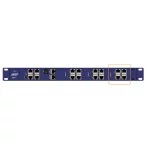A data centre digital twin is a 3D digital model of the physical design and layout of a data centre or server room. A digital twin can be used for a range of purposes including simulations, integration, testing, monitoring, maintenance, load planning and capacity planning. In a data centre environment, a virtual digital twin can be used to analyse cooling, airflow, energy, and power usage. The model can help to identify potential performance improvements and model their outcomes.
Data Centre Digital Twin Modelling Software
ACKPro Server Software includes digital twin modelling and simulation features to allow data centre managers to compare design and real world performance in order to identify areas of concern such as process failures, single points of failure, capacity planning changes and areas requiring preventative action. The software uses data collection from sensorCFD, server cabinet thermal maps and other intelligent sensors, collected via an AKCP sensorProbe+ environmental monitoring device. The AKCP Digital Twin Software platform provides a real-time optimisation tool for all sizes of data centre from small Edge sites to colocation and mega datacentre facilities.
-
Applications (40)
- Temperature & Humidity (29)
- Water Leakage Detection (27)
- Server Rack Monitoring (28)
- Hardwired Ethernet Devices (28)
- Wi-Fi Connectivity Units (8)
- Wireless Devices (13)
- Narrowband IoT Devices (4)
- GSM / LTE Comms (7)
- Battery Monitoring (7)
- Branch Circuits (2)
- Power Monitors (28)
- Security Monitors (26)
- Data Centres (7)
- Data Loggers (11)
- Data Aquisition Systems (9)
- Accessories (160)
Digital Twin Benefits for Data Centre Operators
Data centre digital twins provide several advantages for data centre operators and facilities managers. The model can provide insights into IT, critical system (cooling and power), design and capacity utilisation, in addition to mapping out the network and critical power path. Data analysis can help to identify areas for improvement, energy saving and capacity optimisation.
Building Digital Twins
The first step is to build a virtual model of the physical data centre space. This can take time for a large data centre but a faster approach and potentially more accurate one, can be to model a specific containment pod (mini data centre). Some aisle containment system manufacturers can supply virtual models of their hot and cold-aisle containment pods for use in software such as AKCPro Server software. This speeds up significantly, creation of the digital twin model.
Real-time Intelligent Data Monitoring and Analytics
The next stage is to install intelligent sensors within the physical data centre environment and specifically at the server rack level. The best sensor for digital twin data collection are AKCP cabinet thermal cabinet map and power meter sensors. Designed for server racks and aisle containment pods from Panduit, Subzero, Schneider and more. For airflow mapping, the AKCP sensorCFD can be used to collect sensor data. CFD stands for Computational Fluid Dynamics (CFD) and the data can be used to produce a graphical representation of airflow and cooling performance.
A comprehensive digital twin will include data on energy consumption, rack inlet and outlet temperatures, humidity, water leak detection, and of course the physical assets. This granular monitoring and data collection level, allows data centre managers and engineers to detect critical issues and respond with corrective and preventative actions.
Predictive Maintenance for Critical Systems
Sensor data analysis can also be used to predict equipment failures and schedule preventative maintenance. Regular maintenance is known to reduce downtime and repair costs and help to extend the overall working life of critical devices.
Virtual Simulations for Predictive Analysis
A digital twin allows for critical system simulations in a virtual setting. Examples include failure of the cooling system or a failure within the critical power path, including failure of an uninterruptible power supply, a breaker tripping or overloading of a PDU.
Capacity Planning for Datacentre Operators
Capacity planning is an important part of the data center management process. Demands do vary and future changes must be planned. A digital twin allows for capacity planning simulations so that changes in loading and utilisation can be mapped.
CFD Analysis and Data Accuracy
Digital twins are only as accurate a tool as the data provided. This is especially true for CFD analysis and computations. Without accurate and intelligent data, the room for error can be significant. For accurate CFD results, accurate real-world data is required. This can be achieved using the ACKP sensorCFD device.
Free Digital Twin Software Demo

By creating a digital twin of a data centre, it is easier to manage, monitor and plan for changes within the data centre, improve resilience and maintain uptime. Please contact our projects team for more information or book an online demo.
AKCP YouTube Video on the CFD Analysis and Digital Twin Modelling
Containment POD and Aisle Management
Mapping containment PODs provides a smaller space in which the hot or cold air is contained. This provides an easier system to control, monitor and model, than a complete data centre.
Within this, thermal cabinet map sensors can be used to collect data within server cabinets, at the rack inlets and outlets. With top, middle, and bottom, front and rear level monitoring, true Delta-T values can be calculated. AKCP power meters can also be installed for each server rack to measure the heat generated. Both sets of data help to make the digital twin highly accurate. In addition, as the data centre expands, additional PODs can be rolled out using the same configurations to ensure modelling and performance consistency.
Please contact our Projects Team for a free data center digital twin software demo. We can use Microsoft Teams or Google Meet to host a meeting and provide you with a free online demo of the AKCPro Server software and the digital twin features that will help you to manage power within your critical facilities, raise resilience level, improve business continuity planning and improve energy efficiency.

Earn SRE points on all online purchases with double points on selected products

































